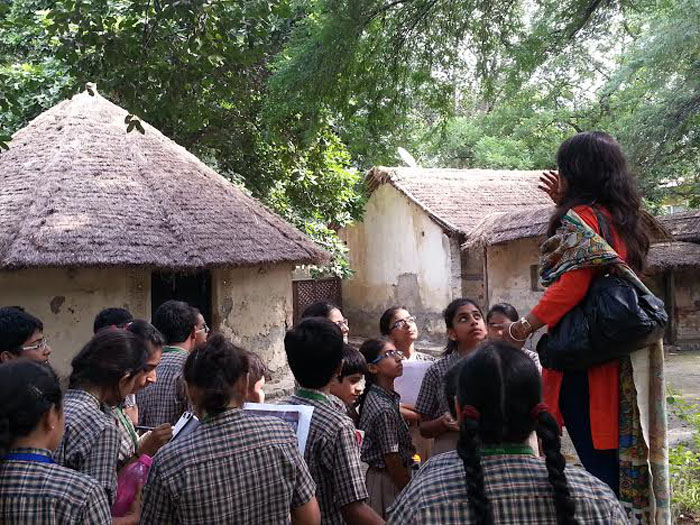Flow India School Programme-A Journey Down The West Coast
We were lucky to be a part of a three-day workshop organised at our School by FLOW INDIA. The theme for the workshop was Gateway To India-A Journey Down The West Coast. We were doubly excited as the theme also happens to be the theme of the year at our School!
13 October , 2014 was the first day of the workshop. We were naturally excited and exchanged opinions amongst our groups about what the workshop would offer us. But we did not have to wait long to find out that the three days of the workshop would be both enriching and fun-filled!
The workshop commenced with a powerpoint presentation showcasing the different traditions, art, culture, cuisines, textiles, tourist destinations etc. of the states along the west coast of India. We were amazed to know so much about a region we thought we knew! Perhaps quite like many an adventurer, ignorant voyager, royal envoy, eager trader or community fleeing its homeland stumbled upon the western coast of India, some to their amusement, others to their dismay!
[gallery]
The Parsis, Arabs, Armenians and Ethiopians were a few of the early foreigners to have made some significant contact with the coast. They were soon followed by the formidable Europeans, namely, the Dutch, the Portuguese, the English and the French. Each brought its own socio-cultural influenced causing major transformations in the general fabric of the socio-economic culture of the region. Some like the Parsis and the Arabs continued to live on as they came , providing a significant intermingling of traditions, values and practices that exist in our country even today.
We were divided into groups of four and given an interesting task. All the groups were given printed snippets about different foreign trading communities that forayed into the western coast for purposes of trade. Two members of each group were to dramatise this with two posing as ocal people of the coast and the other two as foreign tradesmen. We then prepared skits within our groups and presented these for the audience. It was great fun!
The second day of the workshop had an outing in store for us. We went to the Crafts Museum where we had a wonderful time. The weather supported us as the Sun hid behind the clouds and a cool breeze offered respite from the heat. The museum was a great source of information on the western coast as it highlighted the various art forms of the region along with its textiles and fabrics.
As we entered the Craft Museum, we saw samples of Warli art from Maharashtra on the walls and the gates. The wall paintings from the tribal regions along the western coast of India are not only visually stunning examples of indigenous art, but also a unique record of human memory of everyday life. We observed the paintings closely as we were asked to translate the images into small stories and write them in our booklets provided to us by the organisers.
On moving further inside the museum, we saw big banyan trees next to a village complex. The complex showcased life-sized traditional dwellings from different states. The first house we saw was a Rajasthani haveli made of sandstone and wood, with intricate patterns on the walls which gave a royal look to the architecture. Among many other houses depicting diverse architecture, we saw a Banni Hut of Gujarat, with circular walls to enable hot blowing winds to circulate about the house and prevent them from heating up fast.
The textile section was next on the list. It was an amazing and rich amalgamation of different textiles from all over India, especially the states along the west coast. It was here that we learnt that India has been producing textiles for more than 4000 years, and during most of that time, it has been supplying to a thriving export market.
The ports of the west coast served as key points to this trade. We witnessed beautiful textiles, namely the Ikats, Kalamkaris, Silk brocades, muslins, shawls and breathtaking pieces of embroidery. One another interesting fact we learnt was that India was foreign to the idea of stitched clothing until the coming of the Persians and the Arabs, who brought with them the art of stitching. The people of India wore unstitched pieces of clothing before earlier!
On our way back to the exit gate, we passed a small market complex where colourful clothes from different states were being sold. We even saw a weaver from Orissa weaving on a handloom. We spoke to him about his work and the kind of sarees he wove.. The second day of the workshop came to an end on this informative note.
The third day was spent in the A.V. Room at School where we designed posters to 'promote tourism in any one state of the western coast', of our choice. We showcased the diversity of the states, highlighting the food and places of interest. Many of us came up with very creative designs which were appreciated by the teachers from FLOW INDIA.
We thank School for giving us this wonderful opportunity to be a part of this workshop. We hope the information we gathered from this workshop will go a long way in helping us in our endeavors to know more about our amazing country.
Reported by Khushi Kedia VI B, and Jessica Wadhwa VI C and Ms. Gandharvi Mukherjee.













